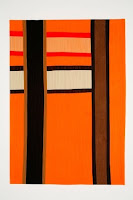 |
| Antique Primitive Red Rug |
Rug hooking has a very long history. In North America, rug hooking has its roots as original folk art. Once a craft utilized to cover the drafty floors of primitive settlers' homes, it is now a fine art practiced by talented and skilled artists. In its earliest years, rug hooking was a craft of poverty, using strips of used material, among the first examples of recycling. In the past few decades, rug hooking has reached new heights as a fine art form, and modern rug hooking is often described as painting with wool.
 |
Three Churches of Mahone Bay with Gazebo
Hooked by Janice Daniels
Design by Encompassing Designs | |
|
|
|
The mother of modern rug hooking is Pearl McGown. In the 1930s, she popularized guidelines for rug hooking, formalized its study and established the modern preference for using only cut wool strips in hooked rugs. Her vision of rug hooking and teaching grew into a family business and then beyond as she was determined that rug hooking not become a lost art.
 |
I Have My Eye on You
Designed and Hooked by Christine Gibson |
Recently, hookers have followed quilters in exploring new materials and developing techniques. This experimentation, combined with knowledge of the past, has allowed rug hooking to evolve and grow. Rug hooking today falls into two genres, primarily based upon the width of the wool strips used to create a rug: fine and primitive hooking. Generally speaking, fine hooking uses very small strips of wool. Designs of the fine-hooking genre use more fine shading, accomplished by over dyeing wool in gradated colour swatches. On the other end of the spectrum, primitive (or wide-cut) hooking uses wider strips of wool (up to a 1/2 inch wide). The wide-cut hooking accomplishes shading and highlights using textures in wool, such as plaids, checks and herringbones. Wide-cut designs are generally less detailed and tend to mimic rugs of the past (pre-McGown designs).
 |
Patrick & Logan Summer 2009
Hooked by Trish Johnson |
|
|
A big Canadian connection to hooking is Loretta Bluher-Moore who stumbled upon rug hooking by chance. On impulse, Lorette purchased a rug hooking kit, which got her started down on a path to artistic fulfillment. She attended rug hooking class in Montreal, where she credits her teacher with instructing her how to dye wool. Loretta loves creating exactly the right hues to execute her original designs. Of colour, she says "when you can control the colours, it opens up so many possibilities!"
 |
Robertson Glacier
Designed & Hooked by Betty Calvert |
|
Within a few years of taking up hooking, Loretta was invited to exhibit and demonstrate traditional rug hooking at a show in Roxham, Quebec. She sold dyed wool and was inundated by people asking for lessons and kits, so Loretta created her first rug hooking kit.
 |
| Irises |
In addition to creating unique pieces to sell and for herself, Loretta has developed a number of kits for hooked wall hangings, seat covers, runners, rugs and purses. She also enjoys the artistic challenge of designing specialty items on commission as well as teaching. Loretta was featured in a fall issue of A Needle Pulling Thread, a Canadian fibre arts magazine, along with one of her traditional hooked patterns.
 |
| Celtic Flow |
The Running Stitch is excited that it will start retailing wool and rug hooking kits in the near future!

























































